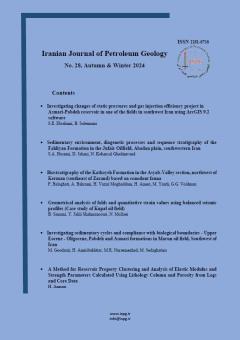A Method for Reservoir Property Clustering and Analysis of Elastic Modulus and Strength Parameters Calculated Using Lithology Column and Porosity from Logs and Core Data
Subject Areas : Petroleum Geology
1 -
Keywords: Reservoir Grouping, Multi-Resolution Graph-Based Clustering, Elasticity and Strength Parameters,
Abstract :
Determining rock types and calculating the elastic and strength parameters of formations are among the most fundamental and complex petrophysical–geomechanical parameters in hydrocarbon reservoirs. Their accurate calculation forms the basis for many petroleum engineering and reservoir geomechanics studies. To this end, in the first stage of the present research, the optimal number of electrofacies was obtained for the studied well using a multi-partition clustering method based on the MRGC[1] graph, derived from a combination of geological data and both conventional and synthetic logs, including VDL[2] and NDS[3]. The proposed algorithm incorporates lithology effects and porosity types into calculations for accurate reservoir grouping. At this stage, five optimal electrofacies classes and groups were identified for the studied well using the MRGC-based clustering method. In the second stage, considering that calculating and estimating elastic and rock strength coefficients is essential in geomechanical studies – and since core data is not available throughout the entire well – calculations were made for Young’s modulus, Poisson’s ratio, bulk modulus, shear modulus, and uniaxial compressive strength using dipole sonic imaging (DSI) logs. The comparison of calculated elastic moduli and strength parameters with variations in the lithology column and porosity from petrophysical evaluation and core data confirms that as core and log porosity increase, the values of elastic moduli and strength parameters decrease. Hence, porosity has an inverse relationship with elastic moduli and strength parameters. In the present study, the correlation coefficient between the calculated bulk modulus and porosity was found to be (R2 = 0.82), shear modulus (R2 = 0.73), Young’s modulus (R2 = 0.77), Poisson’s ratio (R2 = 0.049), uniaxial compressive strength (R2 = 0.84), and uniaxial tensile strength (R2 = 0.65).
[1] Multi-resolution graph-based clustering
[2] Velocity Deviation Log
[3] Neutron- Density Separation
• Anselmetti, F.S. and Eberli, G.P., 1999. The velocity-deviation log: A tool to predict pore type and permeability trends in carbonate drill holes from sonic and porosity or density logs. AAPG bulletin, 83(3), pp.450-466.
• Amirsardari M., 2020. Reservoir Rock Typing Based on Petrophysical and Special Core Data in one of the Carbonate Reservoir in Perisan Gulf. KJES; 6 (2) :235-254
• Aghanbati,A. 2004. "Geology of Iran", Tehran, Geological Survey, First Edition.
• Ammarloo, H., Zoughy, P., Mehraban, L. F., & Amiri, M. (2025). Evaluation of empirical relationships in carbonates by developing a 1D mechanical earth model in an oil field in Southwestern Iran. Results in Engineering, 26, 104799.
• Al-Qahtani, M.Y. and Zillur, R., 2001, March. A mathematical algorithm for modeling geomechanical rock properties of the Khuff and Pre-Khuff reservoirs in Ghawar field. In SPE Middle East Oil and Gas Show and Conference (pp. SPE-68194). SPE.
• Ezati, M., Azizzadeh, M., Riahi, M.A., Fattahpour, V. and Honarmand, J., 2020. Wellbore stability analysis using integrated geomechanical modeling: a case study from the Sarvak reservoir in one of the SW Iranian oil fields. Arabian Journal of Geosciences, 13, pp.1-19.
• Gholami, R., Rasouli, V., Aadnoy, B. and Mohammadi, R., 2015. Application of in situ stress estimation methods in wellbore stability analysis under isotropic and anisotropic conditions. Journal of Geophysics and Engineering, 12(4), pp.657-673.
• Motiei, E. 1993. "Geology of Iran, Zagros stratigraphy", Tehran, Geological Survey, First Edition.
• Ohen, H.A., Ajufo, A.O. and Enwere, P.M., 1996, January. Laboratory NMR relaxation measurements for the acquisition of calibration data for NMR logging tools. In SPE Western Regional Meeting. Society of Petroleum Engineers.#3 • Perez, H.H., Datta-Gupta, A. and Mishra, S., 2005. The role of electrofacies, lithofacies, and hydraulic flow units in permeability predictions from well logs: a comparative analysis using classification trees. SPE Reservoir Evaluation & Engineering, 8(02), pp.143-155.
• Sfidari, E., Kadkhodaie-Ilkhchi, A. and Najjari, S., 2012. Comparison of intelligent and statistical clustering approaches to predicting total organic carbon using intelligent systems. Journal of Petroleum Science and Engineering, 86, pp.190-205.
• Soleimani, B., Moradi, M. and Ghabeishavi, A., 2018. Stoneley wave predicted permeability and electrofacies correlation in the Bangestan Reservoir, Mansouri Oilfield, SW Iran. Geofísica internacional, 57(2), pp.107-120.
• Ye, S.J. and Rabiller, P., 2000, January. A new tool for electro-facies analysis: multi-resolution graph-based clustering. In SPWLA 41st annual logging symposium. Society of Petrophysicists and Well-Log Analysts.

